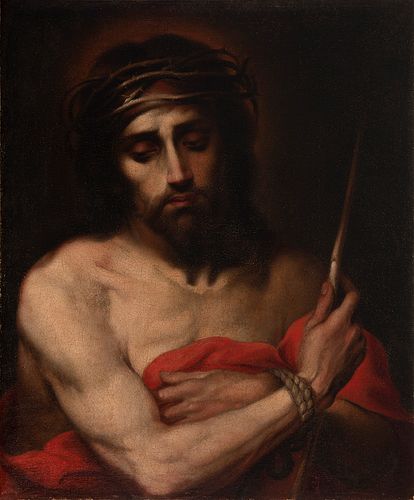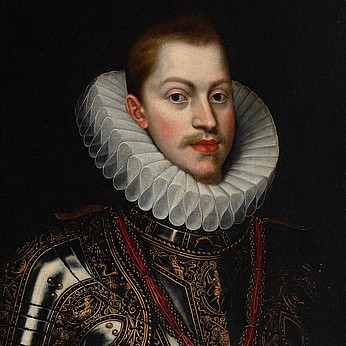Workshop of BARTOLOMÉ ESTEBAN MURILLO (Seville, 1617 - Cadiz, 1682). "Ecce Homo. Oil on canvas. Relined.
Lot 65
About Seller
Setdart Auction House
Carrer Aragó 346
Barcelona
Spain
Setdart Subastas was born in 2004 and is currently the first online art auction in Spain with solidity, prestige and reliability guaranteed by our more than 60,000 users. Setdart has a young, dynamic and enterprising team ready to successfully manage the purchase and sale of art works through custom...Read more
Estimate:
EUR€12,000 - EUR€14,000
$12,903.23 - $15,053.76
Absentee vs Live bid
Two ways to bid:
- Leave a max absentee bid and the platform will bid on your behalf up to your maximum bid during the live auction.
- Bid live during the auction and your bids will be submitted real-time to the auctioneer.
Bid Increments
| Price | Bid Increment |
|---|---|
| EUR€0 | EUR€10 |
| EUR€200 | EUR€25 |
| EUR€500 | EUR€50 |
| EUR€1,000 | EUR€100 |
| EUR€3,000 | EUR€200 |
| EUR€5,000 | EUR€500 |
| EUR€10,000 | EUR€1,000 |
| EUR€20,000 | EUR€2,000 |
| EUR€50,000 | EUR€5,000 |
About Auction
By Setdart Auction House
Nov 24, 2021
Set Reminder
2021-11-24 09:00:00
2021-11-24 09:00:00
America/New_York
Bidsquare
Bidsquare : Old Masters, Day 1
https://www.bidsquare.com/auctions/setdart-auction-house/old-masters-day-1-7873
Setdart Auction House sofia@setdart.com
Setdart Auction House sofia@setdart.com
- Lot Description
Workshop of BARTOLOMÉ ESTEBAN MURILLO (Seville, 1617 - Cadiz, 1682). "Ecce Homo. Oil on canvas. Relined. Presents restorations. Measurements: 50 x 60 cm. The work gives off an emotional devotional tension clarified by the darkness of the scene, the expressiveness of the red mantle and the definition of Christ's anatomy. The face, perfectly modeled, stands out for the play of volumes and the truthfulness of the features. They show us a concentrated Jesus, with lowered eyelids and a serious face, aware of his destiny. Only the rod he holds in his hands breaks the viewer's concentration on the body of Christ, however, its presence is barely perceptible as it blends into the darkness of the background. The quality of this religious portrait invites us to think about the artistic production of Murillo's workshop, since the work presents similarities with pieces of the same theme attributed to the master, an example of this is the painting that belongs to the Museum of Cadiz, where in spite of the differences, the composition and the conception of the figure of Jesus present great similarities. The theme of Ecce Homo belongs to the cycle of the Passion, and immediately precedes the episode of the Crucifixion. Following this iconography, Jesus is presented at the moment when the soldiers mock him, after crowning him with thorns, dressing him in a purple robe and placing a reed in his hand, kneeling down and exclaiming "Hail, King of the Jews!". The words "Ecce Homo" are those pronounced by Pilate when presenting Christ before the crowd; their translation is "behold the man", a phrase by which he mocks Jesus and implies that Christ's power was not such in front of that of the leaders who were judging him there. Little is known about Murillo's childhood and youth, except that he lost his father in 1627 and his mother in 1628, which is why he was taken under the tutelage of his brother-in-law. Around 1635 he must have begun his apprenticeship as a painter, very possibly with Juan del Castillo, who was married to a cousin of his. This working and artistic relationship would last about six years, as was customary at the time. After his marriage, in 1645, he began what was to be a brilliant career that progressively made him the most famous and sought-after painter in Seville. The only recorded trip he made is documented in 1658, the year in which Murillo was in Madrid for several months. It may be thought that at the court he maintained contact with the painters who resided there, such as Velázquez, Zurbarán and Cano, and that he had access to the collection of paintings in the Royal Palace, a magnificent subject of study for all those artists who passed through the court. Despite the few documentary references regarding his mature years, we know that he enjoyed a comfortable life, which allowed him to maintain a high standard of living and several apprentices. Having become the first painter of the city, surpassing in fame even Zurbarán, moved his will to raise the artistic level of local painting. For this reason, in 1660 he decided, together with Francisco Herrera el Mozo, to found an academy of painting, of which he was the main promoter. His fame spread to such an extent, throughout the national territory, that Palomino indicates that around 1670 King Charles II offered him the possibility of moving to Madrid to work there as a court painter. We do not know if this reference is true, but the fact is that Murillo remained in Seville until the end of his life. His works are currently kept in the most important art galleries in the world, such as the Prado Museum, the Hermitage in St. Petersburg, the Kunsthistorisches in Vienna, the Louvre in Paris, the Metropolitan in New York or the National Gallery in London.
- Shipping Info
-
In-house shipping available. Please inquire at admin@setdart.com.
-
- Buyer's Premium



 EUR
EUR CAD
CAD AUD
AUD GBP
GBP MXN
MXN HKD
HKD CNY
CNY MYR
MYR SEK
SEK SGD
SGD CHF
CHF THB
THB















